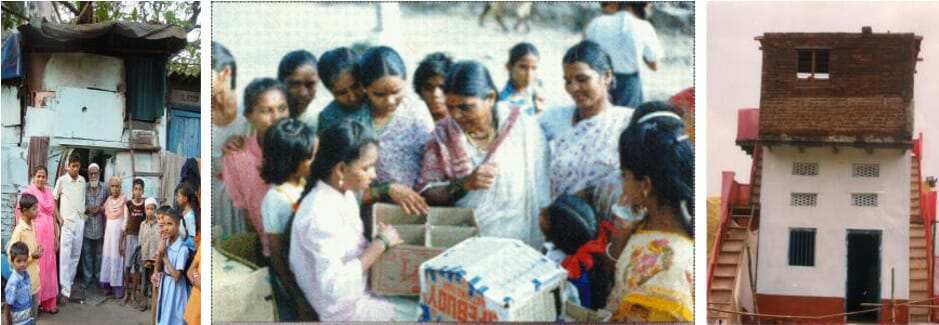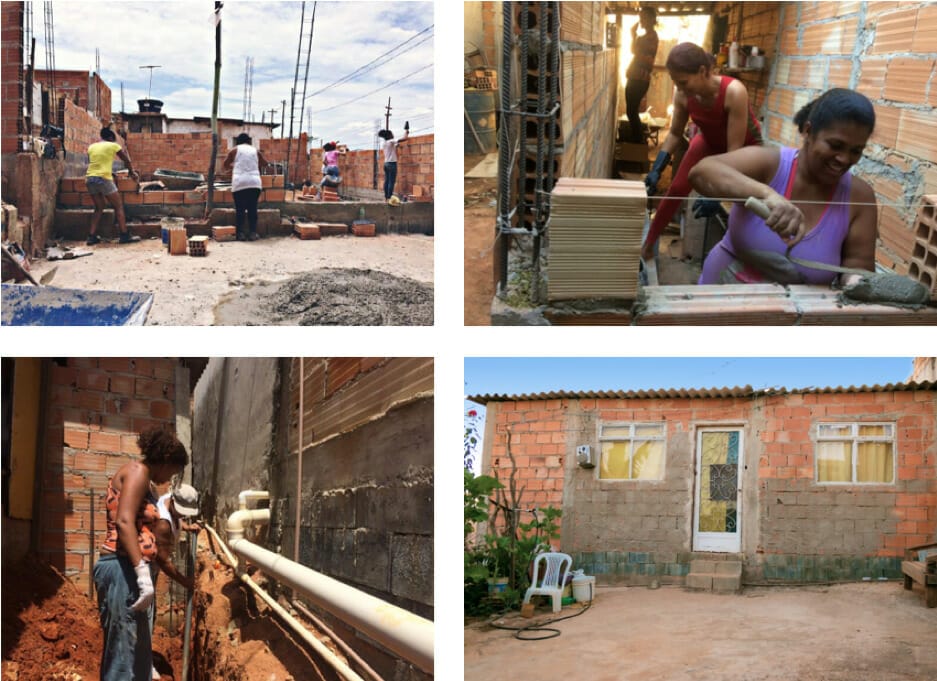The gender gap in architecture is slowly but surely diminishing. We now have more women in all branches of the industry, than ever before. While the voices of women are finally getting into discussions about the future of our cities, let’s look at some of the initiatives around the world that promote the participation of local women in the process of home building, construction, and urban design.
Mahila Milan, India
Mahila Milan translated as ‘women together’, is a self-organised, decentralized network of women living on the pavements of the city of Mumbai. This collective was formed in 1986, as a response to the government’s decision to demolish informal structures on the sidewalks of the city. With the support of the National Slum Dwellers Federation (NSDF) and the Society for the Promotion of Area Resource Centres (SPARC), founded by Sheela Patel, the female pavement dwellers came together to find ways to build up their community and co-exist within the city.
Pavement dwellers and marginalized communities don’t get counted under the census or considered under public policy. The organizations helped the women with legal and governmental aid to earmark areas for their occupation, thereby making them seen. These women, despite being illiterate, planned, designed, and built functional homes that met their needs, and also provided sanitation solutions for their community settlements.
Over the decades, Mahila Milan has gone on to work for the better development of informal settlements and cities across the country. They’ve even helped set up local community-based credit unions in these areas. SPARC also supports them in running Milan Nagar – a co-operative that helps the needy with food, clothing, banking facilities, financial assistance, and in emergencies.
On the international front, the initiative has formed tie-ups with agencies and similar initiatives in the US, Africa, and Europe, conducting workshops and exhibitions, setting an example for the world to follow.

Architecture in the Periphery, Brazil
Brazil is a country with distinct social and economic inequality, which includes the lack of proper housing and infrastructure for a majority of the population. In most territories, people tend to build their own homes, without really knowing how to go about it.
Architect Carina Guedes realized this issue at large during her master’s thesis and wanted to find ways to help solve this very evident local issue. She started the ‘Architecture in the Periphery’ project in 2014, intended to provide technical assistance and construction courses to women in underdeveloped areas of Brazil. These courses teach them the basic requirements of a dwelling unit (like ventilation and sanitation), climatic constraints (natural light, humidity control, etc.), types of materials, construction methods, etc.
Women often feel their needs and opinions are not considered while designing or building their homes, although they are the ones who spend the most time in the space. This scenario has significantly changed with the launch of Guedes’ initiative. Women are now equipped with the knowledge to make changes themselves and therefore, have a say. The project also provides small housing loans to women, teaching them basic financial management and making them more independent.

Her City, Global
On Women’s Day 2020, Global Utmaning, a Swedish independent think tank, joined forces with UN-Habitat to launch the Her City Toolbox – an open-source digital platform that promotes the participation of girls in urban planning and designing. The idea stems from the understanding that women are better designers as they can design with diversity, incorporating the various needs of different categories of users.
Cities are supposed to be built and used by all; but we often see that men get an upper hand in designing them, giving more importance to their own needs. This is the main issue that the initiative aims to tackle. Her City brings in the voices of girls into the design conversation, promoting a more balanced approach, reducing the gender gap, and making our cities more inclusive.
The digital platform offers a toolbox containing nine building blocks that serve as a guide to cost-effectively co-plan cities involving girls and considering their perspectives. These blocks come in sets of threes, each representing one of the three phases of the design process: the assessment phase, the design phase, and the implementation phase. The tools include templates, checklists, guides, forms, surveys, agendas, boards, apps, and visualization programs such as MethodKit and Minecraft.
The initiative aimed at attaining most of the Sustainable Development Goals (SDGs) has become an integral part of the 2030 UN Agenda. Her City has so far launched 125 initiatives across 315 cities in 95 countries and is expanding even faster.





















